A Harmonic Based Pilot Protection Scheme for VSC-MTDC Grids with PWM Converters
Abstract
1. Introduction
- WT and FT do not describe the frequency changing with time, while HHT gives the instant frequency of the transient waves with the most accurate results. FT gives signal information only in frequency resolution, and WT gives a time-frequency resolution with a trade-off between the accuracy in time or frequency. However, HHT gives signal information in time-instant frequency resolution in an accurate form.
- In HHT the processed data are only dependent on the inherent characteristics of the signal, with no adjustments of the algorithm parameters, which result in more accurate and faster signal processing results. However, in WT, the signal is sifted according to the type of mother wavelet and the decomposition level, causing noticeable differences to the accuracy of the results.
- This paper analyses the flow of FCFH current in VSC-MTDC grids in different situations. For different regions of the system, the behavior of the FCFH fault current in external and internal faults is compared and a methodology for selective fault detection ins VSC-MTDC grids is proposed.
- This paper uses HHT to accurately detect the initial peaks of the FCFH currents with the help if the instant frequency. The detection delay is significantly lower than WT and FT-based methods. Additionally, WT and FT-based frequency analysis deal with constant frequency detection in different levels, while HHT can determine abrupt time-varying changes in dominant frequency within a certain EMD.
- Different PWM converter topologies, namely, two-level and three-level VSCs are used in the simulated models to analyses different VSC-MTDC grid topologies and have a more generalized method, applicable to a wider range of systems.
- Multiple faults with different characteristics and types, which involve one or both of the poles including high resistance faults are applied to the system to test the robustness of the method.
- The proposed fault detection algorithm is selective and can accurately detect the faults in different locations of the VSC-MTDC grid regardless of the power flow of the system and the type of inner and outer control system in the HVDC grid.
- Unlike the TW-based methods, the proposed technique does not require to detect the second reflections. The noise sensitivity of the proposed algorithm is less than the transient-based methods, and the selectivity of the proposed technique is significantly higher than over current/over voltage-based methods. The mathematical calculations of the proposed scheme are simpler than AI-based techniques and are practically more feasible.
2. Analysis of FCFH Current in VSC-MTDC Grids
- The first part is the PWM DC offset, claiming .
- The baseband harmonics, which consists of the fundamental frequency component and also the low order frequency component ().
- Carrier wave harmonics, which is the high-frequency component ().
- The sideband harmonics around the carrier harmonic components, which is of interest in designing the proposed protection algorithm.
2.1. External Faults
2.2. Internal Faults
3. The Hilbert-Huang Transform
3.1. Empirical Mode Decomposition (EMD)
3.2. The Hilbert Transform
3.3. Physical Interpretation of HHT
3.4. The Proposed Harmonic Based Protection Algorithm
4. The Test System and the Case Studies
5. Simulation Results
5.1. Case 1: Two-Level VSCs
5.2. Case 2: Three-Level VSCs
5.3. Sensitivity Analysis for Internal Faults
6. Discussion
7. Conclusions
Author Contributions
Funding
Acknowledgments
Conflicts of Interest
Abbreviations
| m | Carrier index. |
| n | Baseband index index. |
| Fundamental frequency. | |
| Carrier frequency. | |
| Harmonic generated by PWM in time domain. | |
| Phase shift angle for the carrier wave. | |
| Phase shift angle for the fundamental wave. | |
| The original unprocessed fault signal. | |
| The ith IMF component extracted by EMD. | |
| The residual component extracted by EMD in the last iteration. | |
| The instant amplitude of the ith IMF component extracted by EMD. | |
| The instant phase of the ith IMF component extracted by EMD. | |
| The instant frequency of the ith IMF component extracted by EMD. | |
| Pole to pole fault. | |
| Positive pole to the ground fault. |
References
- Jovcic, D.; Ahmed, K. High Voltage Direct Current Transmission: Converters, Systems and DC Grids; Wiley: Hoboken, NJ, USA, 2015. [Google Scholar]
- Shakerighadi, B.; Ebrahimzadeh, E.; Blaabjerg, F.; Bak, C.L. Large-Signal Stability Modeling for the Grid-Connected VSC Based on the Lyapunov Method. Energies 2018, 11, 2533. [Google Scholar] [CrossRef]
- Blond, S.L.; Bertho, R.; Coury, D.; Vieira, J. Design of protection schemes for multi-terminal HVDC systems. Renew. Sustain. Energy Rev. 2016, 56, 965–974. [Google Scholar] [CrossRef]
- Zarei, S.F.; Mokhtari, H.; Ghasemi, M.A.; Blaabjerg, F. Reinforcing Fault Ride Through Capability of Grid Forming Voltage Source Converters Using an Enhanced Voltage Control Scheme. IEEE Trans. Power Deliv. 2018. [Google Scholar] [CrossRef]
- Nguyen, V.V.; Son, H.I.; Nguyen, T.T.; Kim, H.M.; Kim, C.K. A Novel Topology of Hybrid HVDC Circuit Breaker for VSC-HVDC Application. Energies 2017, 10, 1675. [Google Scholar] [CrossRef]
- Wang, Y.; Yang, B.; Zuo, H.; Liu, H.; Yan, H. A DC Short-Circuit Fault Ride Through Strategy of MMC-HVDC Based on the Cascaded Star Converter. Energies 2018, 11, 2079. [Google Scholar] [CrossRef]
- Cwikowski, O.; Wood, A.; Miller, A.; Barnes, M.; Shuttleworth, R. Operating DC Circuit Breakers With MMC. IEEE Trans. Power Deliv. 2018, 33, 260–270. [Google Scholar] [CrossRef]
- Li, Y.; Gong, Y.; Jiang, B. A novel traveling-wave-based directional protection scheme for MTDC grid with inductive DC terminal. Electr. Power Syst. Res. 2018, 157, 83–92. [Google Scholar] [CrossRef]
- Zhang, S.; Zou, G.; Huang, Q.; Gao, H. A Traveling-Wave-Based Fault Location Scheme for MMC-Based Multi-Terminal DC Grids. Energies 2018, 11, 401. [Google Scholar] [CrossRef]
- Wang, L.; Liu, H.; Dai, L.; Liu, Y. Novel Method for Identifying Fault Location of Mixed Lines. Energies 2018, 11, 1529. [Google Scholar] [CrossRef]
- Ashouri, M.; Khazraj, H.; da Silva, F.F.; Bak, C.L. Protection of Multi-Terminal VSC-HVDC Grids Based on the Response of the First Carrier Frequency Harmonic Current. In Proceedings of the 2018 53rd International Universities Power Engineering Conference (UPEC), Glasgow, UK, 4–7 September 2018. [Google Scholar] [CrossRef]
- Ashouri, M.; Silva, F.F.; Bak, C.L. Application of short-time Fourier transform for harmonic-based protection of meshed VSC-MTDC grids. J. Eng. 2018. [Google Scholar] [CrossRef]
- Li, S.; Chen, W.; Yin, X.; Chen, D. Protection scheme for VSC-HVDC transmission lines based on transverse differential current. IET Gener. Transm. Distrib. 2017, 11, 2805–2813. [Google Scholar] [CrossRef]
- Li, R.; Xu, L.; Yao, L. DC Fault Detection and Location in Meshed Multiterminal HVDC Systems Based on DC Reactor Voltage Change Rate. IEEE Trans. Power Deliv. 2017, 32, 1516–1526. [Google Scholar] [CrossRef]
- Yang, Q.; Blond, S.L.; Aggarwal, R.; Wang, Y.; Li, J. New ANN method for multi-terminal HVDC protection relaying. Electr. Power Syst. Res. 2017, 148, 192–201. [Google Scholar] [CrossRef]
- Azizi, S.; Sanaye-Pasand, M.; Abedini, M.; Hassani, A. A Traveling-Wave-Based Methodology for Wide-Area Fault Location in Multiterminal DC Systems. IEEE Trans. Power Deliv. 2014, 29, 2552–2560. [Google Scholar] [CrossRef]
- Ashouri, M.; Khazraj, H.; Bak, C.L.; da Silva, F.F. Application of shunt busbar capacitor installations for protection of VSC-MTDC grids. In Proceedings of the 2018 IEEE International Energy Conference (ENERGYCON), Limassol, Cyprus, 3–7 June 2018. [Google Scholar] [CrossRef]
- Jiang, L.; Chen, Q.; Huang, W.; Wang, L.; Zeng, Y.; Zhao, P. Pilot Protection Based on Amplitude of Directional Travelling Wave for Voltage Source Converter-High Voltage Direct Current (VSC-HVDC) Transmission Lines. Energies 2018, 11, 2021. [Google Scholar] [CrossRef]
- Zheng, Z.; Tai, T.; Thorp, J.S.; Yang, Y. A Transient Harmonic Current Protection Scheme for HVDC Transmission Line. IEEE Trans. Power Deliv. 2012, 27, 2278–2285. [Google Scholar] [CrossRef]
- Zheng, X.; Tai, N.; Wu, Z.; Thorp, J. Harmonic current protection scheme for voltage source converter-based high-voltage direct current transmission system. IET Gener. Transm. Distrib. 2014, 8, 1509–1515. [Google Scholar] [CrossRef]
- Delechelle, E.; Lemoine, J.; Niang, O. Empirical mode decomposition: An analytical approach for sifting process. IEEE Signal Process. Lett. 2005, 12, 764–767. [Google Scholar] [CrossRef]
- Nunes, J.C.; Deléchelle, É. Empirical mode decomposition: Applications on signal and image processing. Adv. Adapt. Data Anal. 2009, 1, 125–175. [Google Scholar] [CrossRef]
- Ghomi, M.; Sarem, Y.N.; Kermajani, H.R.; Poshtan, J. Synchronous generator nonlinear model identification using wiener-neural model. In Proceedings of the 2007 42nd International Universities Power Engineering Conference, Brighton, UK, 4–6 September 2007. [Google Scholar] [CrossRef]
- Jahan, H.K.; Banaei, M.R.; Mobaraki, S.T. Combined H-bridge cells cascaded transformers multilevel inverter. In Proceedings of the 5th Annual International Power Electronics, Drive Systems and Technologies Conference (PEDSTC 2014), Tehran, Iran, 5–6 February 2014. [Google Scholar] [CrossRef]
- Honade, T.; Udapure, S.; Timande, S.; Rodge, S.; Burde, V.; Gudadhe, S. Comparative study between two and three level converter for electric application. Int. J. Adv. Eng. Technol. 2016, 9, 210. [Google Scholar]
- Odavic, M.; Sumner, M.; Zanchetta, P.; Clare, J. A Theoretical Analysis of the Harmonic Content of PWM Waveforms for Multiple-Frequency Modulators. IEEE Trans. Power Electron. 2010, 25, 131–141. [Google Scholar] [CrossRef]
- Holmes, D.G. Pulse Width Modulation for Power Converters; Wiley-Blackwell: Hoboken, NJ, USA, 2003. [Google Scholar]
- McGrath, B.P.; Holmes, D.G. A General Analytical Method for Calculating Inverter DC-Link Current Harmonics. IEEE Transa. Ind. Appl. 2009, 45, 1851–1859. [Google Scholar] [CrossRef]
- Rodríguez, A.; Huerta, F.; Bueno, E.; Rodríguez, F. Analysis and Performance Comparison of Different Power Conditioning Systems for SMES-Based Energy Systems in Wind Turbines. Energies 2013, 6, 1527–1553. [Google Scholar] [CrossRef]
- Nguyen, P.; Han, M. Study on harmonic propagation of VSC-based HVDC systems. In Proceedings of the 2014 International Conference on Power System Technology, Chengdu, China, 20–22 October 2014. [Google Scholar] [CrossRef]
- Huang, N.E.; Shen, Z.; Long, S.R.; Wu, M.C.; Shih, H.H.; Zheng, Q.; Yen, N.C.; Tung, C.C.; Liu, H.H. The empirical mode decomposition and the Hilbert spectrum for nonlinear and non-stationary time series analysis. Proc. R. Soc. Lond. Ser. A Math. Phys. Eng. Sci. 1998, 454, 903–995. [Google Scholar] [CrossRef]
- Shi, Q.; Yang, J.; Cao, J.; Tanaka, T.; Wang, R.; Zhu, H. EEG data analysis based on EMD for coma and quasi-brain-death patients. J. Exp. Theor. Artif. Intell. 2011, 23, 97–110. [Google Scholar] [CrossRef]
- Huang, N.E.; Wu, Z. A review on Hilbert-Huang transform: Method and its applications to geophysical studies. Rev. Geophys. 2008, 46. [Google Scholar] [CrossRef]
- Vrana, T.K. The CIGRE B4 DC grid test system. Electrica 2013, 237, 48–57. [Google Scholar]
- Liu, J.; Duan, J.; Lu, H.; Sun, Y. Fault Location Method Based on EEMD and Traveling-Wave Speed Characteristics for HVDC Transmission Lines. J. Power Energy Eng. 2015, 3, 106–113. [Google Scholar] [CrossRef]
- Sun, J.; Saeedifard, M.; Meliopoulos, A.P.S. Backup Protection of Multi-Terminal HVDC Grids Based on Quickest Change Detection. IEEE Trans. Power Deliv. 2019, 34, 177–187. [Google Scholar] [CrossRef]
- Yeap, Y.M.; Geddada, N.; Satpathi, K.; Ukil, A. Time- and Frequency-Domain Fault Detection in a VSC-Interfaced Experimental DC Test System. IEEE Trans. Ind. Inform. 2018, 14, 4353–4364. [Google Scholar] [CrossRef]
- Tang, L.; Dong, X.; Shi, S.; Wang, B. Analysis of the characteristics of fault-induced travelling waves in MMC-HVDC grid. J. Eng. 2018, 2018, 1349–1353. [Google Scholar] [CrossRef]
- Kerf, K.D.; Srivastava, K.; Reza, M.; Bekaert, D.; Cole, S.; Hertem, D.V.; Belmans, R. Wavelet-based protection strategy for DC faults in multi-terminal VSC HVDC systems. IET Gener. Transm. Distrib. 2011, 5, 496. [Google Scholar] [CrossRef]
- Mobarez, M.; Kashani, M.G.; Chavan, G.; Bhattacharya, S. A novel control approach for protection of multi-terminal VSC based HVDC transmission system against DC faults. In Proceedings of the 2015 IEEE Energy Conversion Congress and Exposition (ECCE). IEEE, Montreal, QC, Canada, 20–24 September 2015. [Google Scholar] [CrossRef]
- Liu, J.; Tai, N.; Fan, C. Transient-Voltage-Based Protection Scheme for DC Line Faults in the Multiterminal VSC-HVDC System. IEEE Trans. Power Deliv. 2017, 32, 1483–1494. [Google Scholar] [CrossRef]
- Zhao, P.; Chen, Q.; Sun, K. A novel protection method for VSC-MTDC cable based on the transient DC current using the S transform. Int. J. Electr. Power Energy Syst. 2018, 97, 299–308. [Google Scholar] [CrossRef]
- Zou, G.; Feng, Q.; Huang, Q.; Sun, C.; Gao, H. A fast protection scheme for VSC based multi-terminal DC grid. Int. J. Electr. Power Energy Syst. 2018, 98, 307–314. [Google Scholar] [CrossRef]
- Haleem, N.M.; Rajapakse, A.D. Local measurement based ultra-fast directional ROCOV scheme for protecting Bi-pole HVDC grids with a metallic return conductor. Int. J. Electr. Power Energy Syst 2018, 98, 323–330. [Google Scholar] [CrossRef]
- Tzelepis, D.; Dyśko, A.; Fusiek, G.; Nelson, J.; Niewczas, P.; Vozikis, D.; Orr, P.; Gordon, N.; Booth, C.D. Single-Ended Differential Protection in MTDC Networks Using Optical Sensors. IEEE Trans. Power Deliv. 2017, 32, 1605–1615. [Google Scholar] [CrossRef]
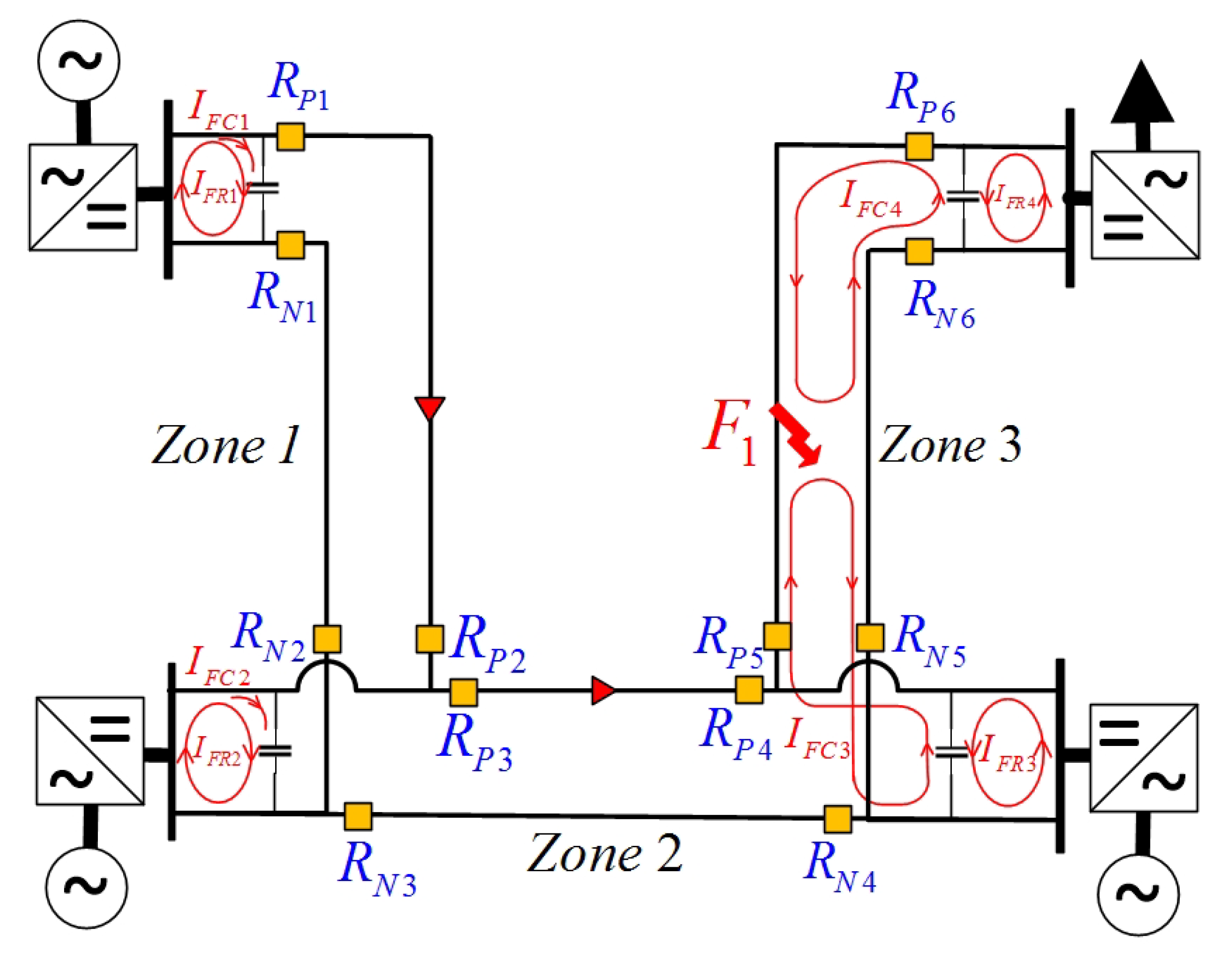

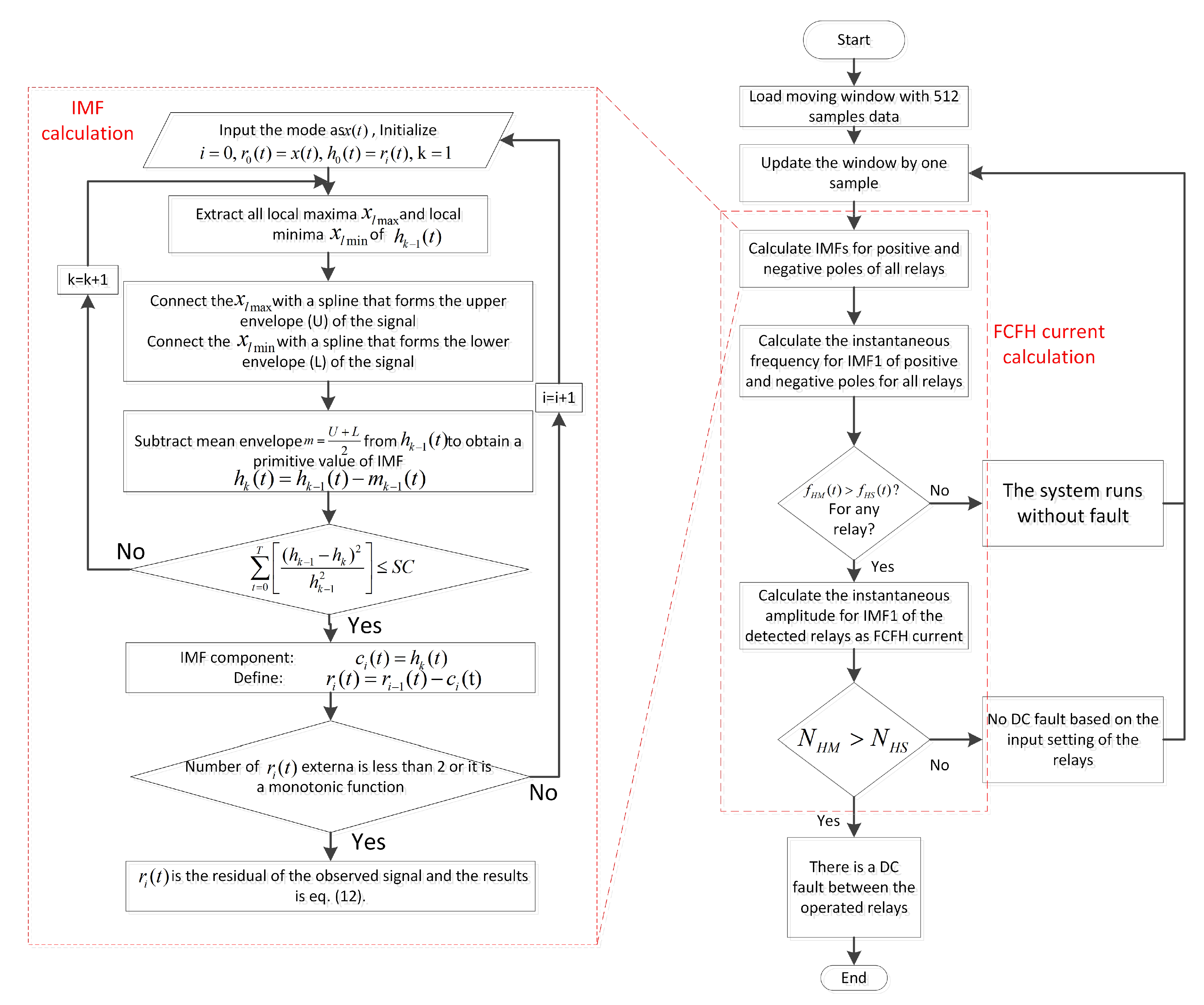


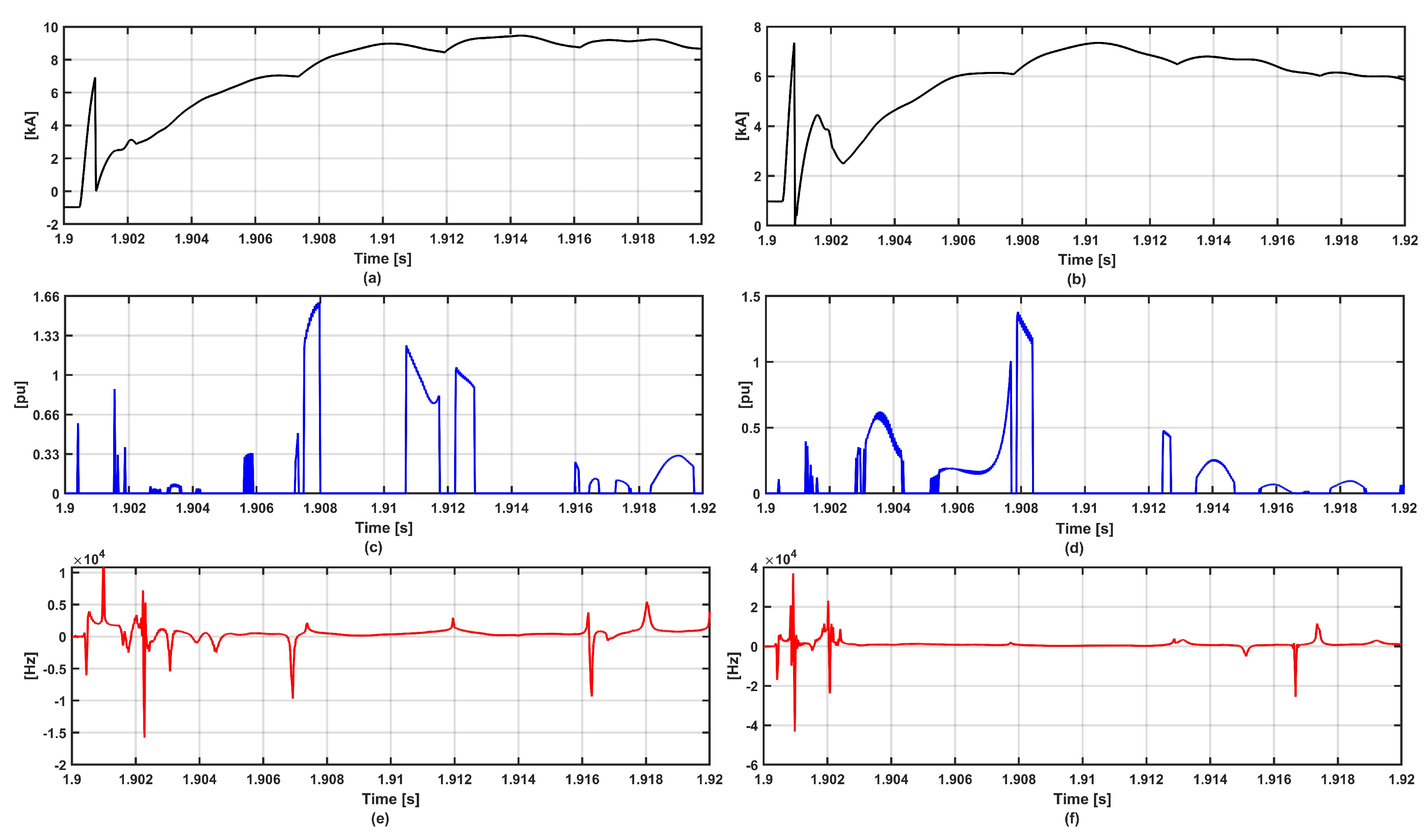
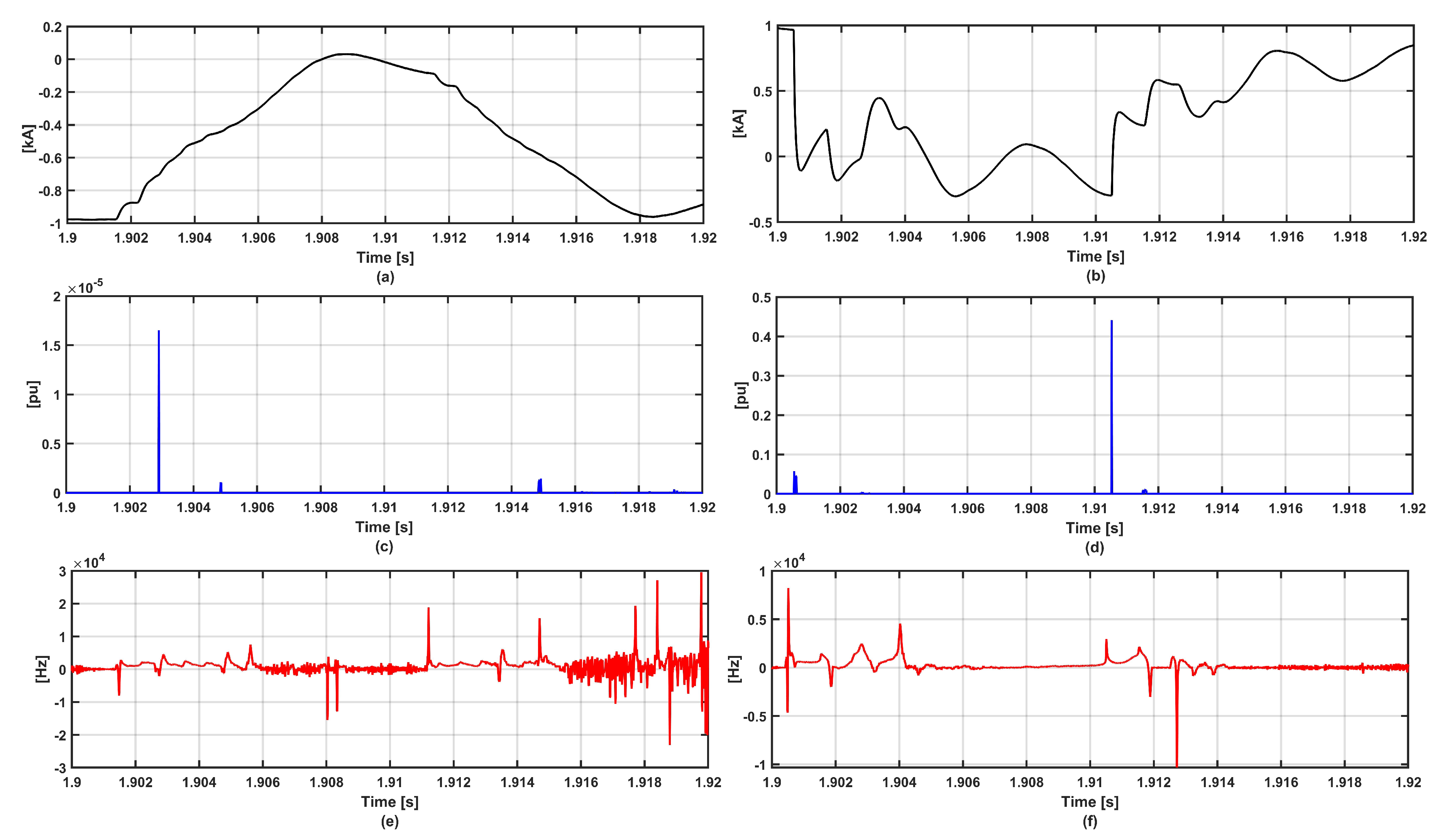
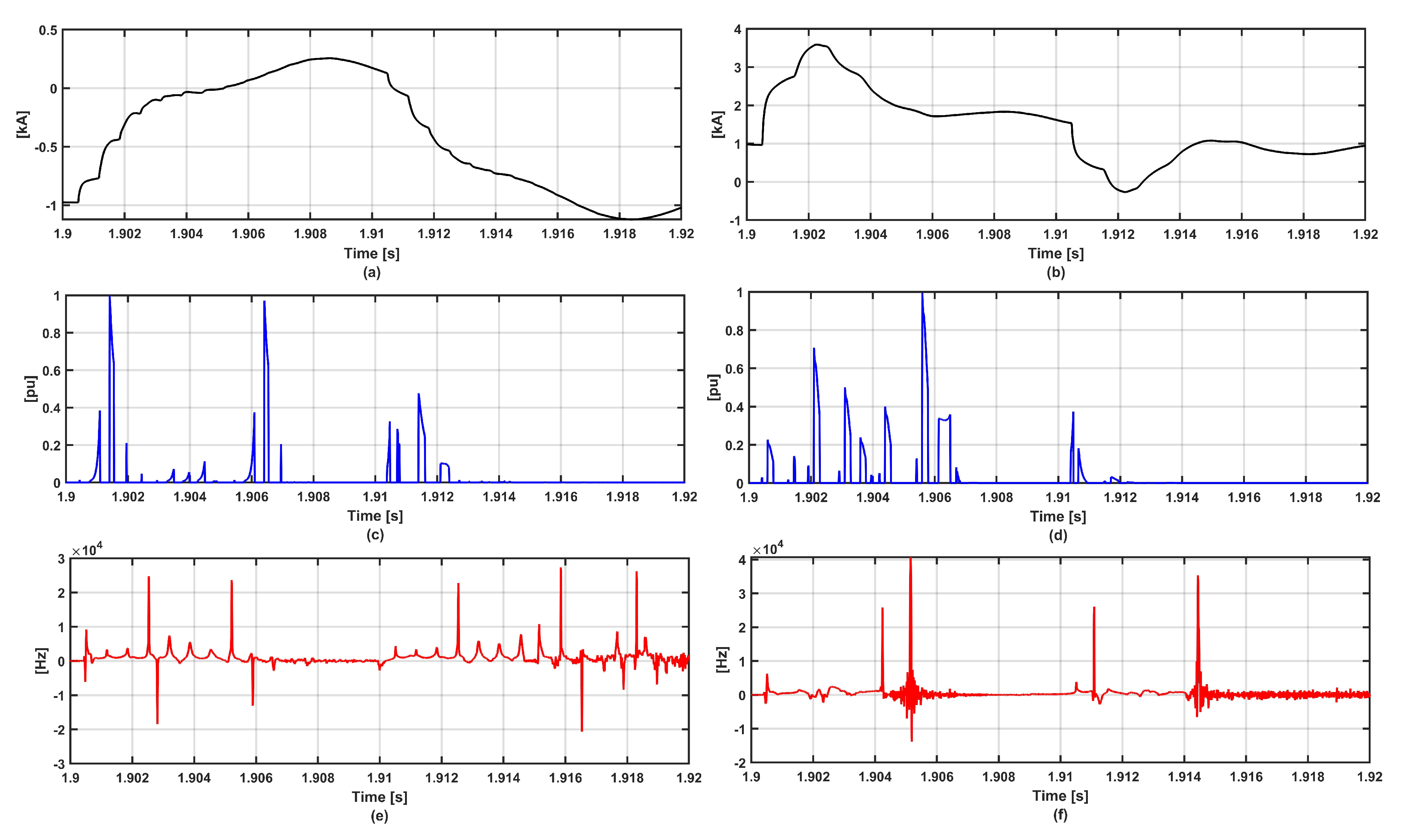
| Busbar | Voltage (kV) | Parameter | Value |
|---|---|---|---|
| Ba-B2 | 380 | P/Vdc, Q | ±200 KV, 400 MW, 0 MVAR |
| Ba-B3 | 380 | P/Vdc, Q | ±200 KV, −800 MW, 0 MVAR |
| B0-F1 | 145 | P, Q | 500 MW, 0 MVAR |
| B0-E1 | 145 | Vac/f | 145 KV, 50 HZ |
| R/X | 0.1 | SC Power | 30 GVA |
| Fault No. | Fault Zone | Fault Type | Resistance (ohm) | Location (km From Right Side) | Duration (s) |
|---|---|---|---|---|---|
| I | 3 | P2P | 1 | 50 | Permanent |
| II | 2 | P2P | 1 | 100 | Permanent |
| III | 3 | PP2G | 50 | 50 | 0.5 |
| IV | 2 | PP2G | 50 | 100 | 0.5 |
| Sampling Frequency [kHz] | Fault Inception Time [s] | [kHz] [35] | [20] | IMF Number Used [31] |
|---|---|---|---|---|
| 100 | 1.9 | 1 | 27 | 1 |
| Fault No. | Relay No. | ~ | Operate | Sample Delay | |
|---|---|---|---|---|---|
| 0.0018 | 1 | - | - | ||
| I | 0.0023 | 1 | - | - | |
| 0.0012 | 1 | - | - | ||
| 0.0012 | 1 | - | - | ||
| 1.057 | 29 | + | 2 | ||
| II | 1.1898 | 29 | + | 1 | |
| 0.8697 | 28 | + | 2 | ||
| 0.9659 | 28 | + | 1 |
| Fault No. | Relay No. | ~ | Operate | Sample Delay | |
|---|---|---|---|---|---|
| 0.001 | 1 | - | - | ||
| III | 0.0015 | 1 | - | - | |
| 0.0011 | 1 | - | - | ||
| 0.0019 | 1 | - | - | ||
| 0.9405 | 36 | + | 3 | ||
| IV | 0.9547 | 31 | + | 3 | |
| 0.1007 | 9 | - | - | ||
| 0.1009 | 6 | - | - |
| F. No. | Zone | Type | Duration | Impedance | Location | Relay | Sample Delay | |
|---|---|---|---|---|---|---|---|---|
| V | 2 | P2P | Permanent | 1 | 1 | 0.7045 | 6 | |
| 1.3452 | 0 | |||||||
| 0.7045 | 6 | |||||||
| 1.3441 | 0 | |||||||
| VI | 2 | P2P | Permanent | 1 | 50 | 0.8001 | 4 | |
| 1.2645 | 1 | |||||||
| 0.7994 | 3 | |||||||
| 1.2640 | 1 | |||||||
| VII | 2 | P2P | Permanent | 1 | 150 | 1.2456 | 1 | |
| 0.8564 | 3 | |||||||
| 1.1150 | 2 | |||||||
| 0.8216 | 3 | |||||||
| VIII | 2 | P2P | Permanent | 1 | 199 | 1.2980 | 1 | |
| 0.7603 | 4 | |||||||
| 1.4456 | 1 | |||||||
| 0.6954 | 6 | |||||||
| IX | 2 | P2P | Permanent | 0.1 | 100 | 1.3569 | 1 | |
| 1.3560 | 1 | |||||||
| 1.3022 | 1 | |||||||
| 1.3024 | 0 | |||||||
| X | 2 | P2P | Permanent | 1 | 100 | 1.1254 | 2 | |
| 1.1356 | 1 | |||||||
| 1.1187 | 1 | |||||||
| 1.1188 | 1 | |||||||
| XI | 2 | P2P | Permanent | 100 | 100 | 0.9578 | 2 | |
| 0.9580 | 2 | |||||||
| 0.9546 | 3 | |||||||
| 0.9555 | 2 | |||||||
| XII | 2 | P2P | Permanent | 500 | 100 | 0.6980 | 3 | |
| 0.7172 | 3 | |||||||
| 0.6968 | 4 | |||||||
| 0.6954 | 4 |
| Reference | Used Method | Detection Time Delay (ms) | DCCB Delay Included | Considerations |
|---|---|---|---|---|
| [15] | ANN | 4.5 | √ | The fault localization time delay is 26 ms |
| [39] | DWT | 0.0375 | - | Used for 2-level VSC-MTDC |
| [40] | TW | 5 | √ | Including operating time for DCCB |
| [41] | Transient | 1.74 | - | Time delay varies for different fault scenarios |
| [42] | S-transform | 2 | - | 1 ms communication delay should be added |
| [43] | TW | 3 | √ | DWT is used for TW detection |
| [44] | ROCOV | <0.2 | - | 2 ms for DCCB should be added |
| [45] | Transient | 1 | - | The method uses distributed optical sensors |
© 2019 by the authors. Licensee MDPI, Basel, Switzerland. This article is an open access article distributed under the terms and conditions of the Creative Commons Attribution (CC BY) license (http://creativecommons.org/licenses/by/4.0/).
Share and Cite
Ashouri, M.; Faria da Silva, F.; Leth Bak, C. A Harmonic Based Pilot Protection Scheme for VSC-MTDC Grids with PWM Converters. Energies 2019, 12, 1010. https://doi.org/10.3390/en12061010
Ashouri M, Faria da Silva F, Leth Bak C. A Harmonic Based Pilot Protection Scheme for VSC-MTDC Grids with PWM Converters. Energies. 2019; 12(6):1010. https://doi.org/10.3390/en12061010
Chicago/Turabian StyleAshouri, Mani, Filipe Faria da Silva, and Claus Leth Bak. 2019. "A Harmonic Based Pilot Protection Scheme for VSC-MTDC Grids with PWM Converters" Energies 12, no. 6: 1010. https://doi.org/10.3390/en12061010
APA StyleAshouri, M., Faria da Silva, F., & Leth Bak, C. (2019). A Harmonic Based Pilot Protection Scheme for VSC-MTDC Grids with PWM Converters. Energies, 12(6), 1010. https://doi.org/10.3390/en12061010






